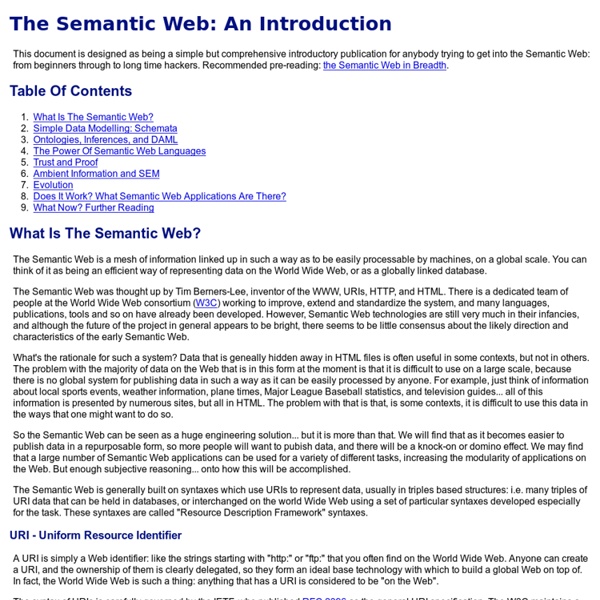Clojure for the Semantic Web - Digital Digressions by Stuart Sie
I dropped in to hear Rich Hickey talk about Clojure at the New York Semantic Web meetup group. Some highlights: • Some programs, like compilers or theorem provers, are themselves functions. They take input and produce output. Purely functional languages like Haskell are good for these kinds of programs. • Most Clojure programmers go through an arc. • Rich recommended a paper, Out of the Tar Pit, for a discussion of functional and relational techniques to manage state. • Clojure’s data structures are persistent. • The first thing Rich did when experimenting with the semantic web was to pull data out of the Jena API and get it into Clojure data structures. Screencasts and code from the talk should appear soon — watch clojure.org or the Clojure Google group for an announcement.
RDF - Semantic Web Standards
Overview RDF is a standard model for data interchange on the Web. RDF has features that facilitate data merging even if the underlying schemas differ, and it specifically supports the evolution of schemas over time without requiring all the data consumers to be changed. RDF extends the linking structure of the Web to use URIs to name the relationship between things as well as the two ends of the link (this is usually referred to as a “triple”). Using this simple model, it allows structured and semi-structured data to be mixed, exposed, and shared across different applications. This linking structure forms a directed, labeled graph, where the edges represent the named link between two resources, represented by the graph nodes. Recommended Reading The RDF 1.1 specification consists of a suite of W3C Recommendations and Working Group Notes, published in 2014. A number of textbooks have been published on RDF and on Semantic Web in general. Discussions on a possible next version of RDF
What is the Semantic Web?
Introduction Many people are not clear as to what the Semantic web is, and as we are the Semantic Web Agreement Group, we need to define it for people. Therefore, here is an attempt at a clear view of the Semantic Web:- The Semantic Web is a Web that includes documents, or portions of documents, describing explicit relationships between things and containing semantic information intended for automated processing by our machines. It operates on the principle of shared data. Clear Intent Although the SW is a Web of data, it is intended primarily for humans; it would use machine processing and databases to take away some of the burdens we currently face so that we can concentrate on the more important things that we can use the Web for. Practical solutions include the use of XSLT to derive RDF from XML sources, the work on topic maps and RDF convergence, the emergence of general-purpose RDF databases and engines, and general and specific GUIs for RDF data. - XML.com An Example Data:- Filter:-
Guide to the semantic web
Greasy Fork - scripts de usuario útiles y seguros
Planète Web Sémantique
The Rise of Contextual User Interfaces
Web 2.0 has brought many wonderful innovations and ideas to the Internet. We can no longer imagine the web without a social dimension, and we can no longer imagine an online world that is read-only - it is now a read/write web full of user-generated content. But there is another fairly recent innovation, which might have just as profound implications. We're speaking of the contextual user interface. Even five years ago we lived in the boxed world of Windows-dominated UIs. There were standard UI elements - menus, tabs, combo boxes, tables - and every single desktop application was full of these elements and nothing else. Strikingly, the recent wave of UI innovation is proving exactly the opposite. Windows UI - The World Of Never-Ending Choices Looking back at the years when Windows dominated our lives one can hardly believe what we put up with. Every imaginable choice was thrown at users at once and it was up to the poor user to figure out what to do. Apple's Revenge
Las relaciones familiares de todas las lenguas de Europa, explicadas en este brillante mapa
Europa es un crisol de lenguas: un vivero que comienza en Tarifa y termina en el Ártico a través del cual conviven y se relacionan entre sí un centenar de lenguas de la más variopinta procedencia. Hay de todo, desde herencias deformadas y antiquísimas del latín hasta monstruos deformes que han terminado dominando el mundo, pasando por idiomas arcanos e ignotos y lenguas que provienen más allá del muro. Si no eres lingüista, hacerse una idea de cómo se relacionan entre sí y de dónde provienen las principales lenguas (y las más pequeñitas) puede convertirse en un quebradero de cabeza. El último y más espectacular con el que nos hemos topado es este realizado por Alternative Transport, un divertido blog anglosajón que atraviesa algunas de nuestras pequeñas obsesiones (transporte, mapas, idiomas, etcétera). El objetivo del mapa es ilustrar cómo de cerca o de lejos están los idiomas entre sí. Las urálicas, incluyendo la lengua húngara, ugria. Las lenguas celtas. Restan los pesos pesados.



